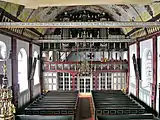Hans Christoph Fritzsche
Hans Christoph Fritzsche (before 1629 – 1674 in Hamburg) was a German organ builder from Dresden who worked in northern Germany, Denmark and southern Sweden.
Life
Fritzsche was the son of the organ builder Gottfried Fritzsche from his first marriage. In 1655, he established his workshop in Copenhagen. There were family ties to Friederich Stellwagen, as he married Fritzsche's sister Theodora. His son-in-law Hans Heinrich Cahman married his daughter Anna Christina and continued the business after Fritzsche died during work on the new building in Hamburg-Neuenfelde.
Proven works
| Year | Location | Church | Picture | Manual | Stops | Notes |
|---|---|---|---|---|---|---|
| 1646 | Handorf | St. Marien | 13 | New building; some stops preserved | ||
| 1647–1649 | Cuxhaven-Altenbruch | St.-Nicolai-Kirche | _011.jpg.webp) |
II/P | 25 | Extension conversion;[1] after further enlargement by Johann Hinrich Klapmeyer (1727-1730) III/P/35 (present condition); 12-16 stops preserved by Fritzsche |
| 1651 (ca.) | Lisbon | Delivery of an organ of unknown size | ||||
| 1652 | Oederquart | St. Johannis | III/P | Including 10 stops of the predecessor organ (1581, badly damaged in 1632); 1678-1682 extension by Arp Schnitger, who moved the organ from the choir loft to the north loft; nothing has survived of the Fritzsche organ. | ||
| 1653 | Oberndorf (Oste) | St.-Georgskirche | Later replaced | |||
| 1655 | Hamburg | St. James' Church, Hamburg |  |
IV/P | 53 ? | 1655-1658 major renovation work for the 1656 Lübische Mark;[2] → main article: Orgel der Hauptkirche Sankt Jacobi |
| 1655 | Copenhagen | Trinitatis Church | III/P | 42 | New building | |
| 1662 | Helsingør | Marienkirche | II/P | 24 | Reconstruction of the Lorentz organ (1634-1636) by order of Dietrich Buxtehude; only the front pipes of the Rückpositiv are preserved. | |
| 1662/63? | Helsingborg | Sankt-Marien-Kirche | II/P | 24 | Work commissioned by Dietrich Buxtehude. The organ was sold to the church of Torrlösa in 1849. | |
| 1666 | Halmstad (Schweden) | II/P | 24 | New building | ||
| 1670–1671 | St. Catherine's Church, Hamburg | IV/P | Extension of the pedal by principal 32' and trombone 32'; the work was not completed (Fritzsche received a payment of 960 Mark lüb.).[3] The work was completed in 1671-1674 during the extension to IV/P 58 by Johann Friedrich Besser (before 1640-1693).[4] ausgeführt. | |||
| 1671 | Dömitz | Johanneskirche | II/p | 13 | New building | |
| 1673 | Hamburg-Neuenfelde | St. Pankratius-Kirche |  |
Completed by Cahman. Later taken by Arp Schnitger to Stade (castle church) and subsequently sold to Bremen.[5] In his new construction, Schnitger integrated older material from two stops by Fritzsche. |
References
- Konrad Küster: „Wolbestimmete Musica ... nach Davids Manier und Gebrauch“. Eine Altenbrucher Trauerpredigt von 1653 als Schlüssel zu norddeutscher Musikkultur. In Stader Jahrbuch 2007 (Stader Archiv, N.F. 97), pp. 55–92; and Orgelstiftung Altenbruch: H.C. Fritzsche
- Fock 1974, pp. 45–56.
- Fock 1974, p. 45
- Uwe Pape and Wolfram Hackel, ed. (2015). Lexikon norddeutscher Orgelbauer. Vol. Bd. 3: Sachsen-Anhalt und Umgebung. Berlin: Pape. pp. 49–50. ISBN 978-3-921140-98-7.
- Neuenfelde, St. Pankratius
Further reading
- Gustav Fock (1974). Arp Schnitger und seine Schule. Ein Beitrag zur Geschichte des Orgelbaues im Nord- und Ostseeküstengebiet. Kassel: Bärenreiter. ISBN 3-7618-0261-7.
- Marc Honegger, Guenther Massenkeil, ed. (1980). Das große Lexikon der Musik. Vol. 3. Freiburg i. Br. [et al.]: Herder. ISBN 3-451-22921-8.
- Kerala J. Snyder, ed. (2002). The Organ as a Mirror of Its Time. Oxford: Oxford University Press. ISBN 0-19-514415-5.
This article is issued from Wikipedia. The text is licensed under Creative Commons - Attribution - Sharealike. Additional terms may apply for the media files.